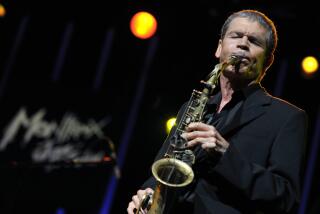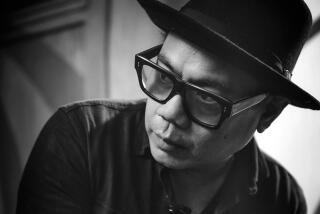A Lot of Skill and a Little Luck : After more than two decades and 200 premieres, guitarist David Starobin’s name is reverberating outside modern music circles.
- Share via
For most of his playing years, classical guitarist David Starobin, who appears Monday at Ambassador Auditorium, has been the musical equivalent of a No. 1 NBA draft pick for any composer who wants his work introduced by a player of surpassing technical skill and an explorer’s alertness to the nuances of discovery.
Elliott Carter, Milton Babbitt and George Crumb are among the lengthy list of composers who have placed their faith in Starobin’s hands (he has premiered more than 200 works since 1975). That may in fact explain why, at 43, he’s not more popularly known outside modern music circles. That condition, happily, is changing.
The reason is partly based on the premise that it never hurts to be lucky as well as good. And in Starobin’s case, lightning has struck twice. He was playing a London concert in 1983 when a student brought a 19th-Century Lacote guitar backstage. On an impulse, Starobin commandeered it for his encore, and instantly it seemed as though he’d been swept up in an H.G. Wells plot that deposited him back in the confident romanticism of the 19th Century.
“I’d picked up a lot of 19th Century guitars before, but I wrote them off as unplayable,” Starobin says. “I was wrong. I’d just never played a good guitar. I realized that the size and the fingerboard really gave back what the composers of the time intended--long, flowing musical lines, with plenty of possibilities for rubato phrasing.”
Starobin, who had cut his teeth on 19th-Century music as a student, soon had a model of Johann Georg Stauffer’s Legnani made by London guitar-maker Gary Southwell (the Stauffer had been played by Schubert and Weber).
He had already begun experimenting earlier with Mario Giuliani sonatas and solo works, and chose Giuliani for his first solo album. The sound instantly provokes an odd sense of discovery and recognition at the same time. Where the Spanish sense of exigency--the flamenco stomp, the flash in the eye--vibrates off the harder, more brilliant soundboard of the Spanish guitar, here the sound is rounder, woodsier, more sweet-tempered and intimate.
Still, as beautiful as the Stauffer is, there was the question of repertoire. There wasn’t a lot of it to challenge the 20th-Century ear. A protean figure like Starobin--who had founded his own record label in 1981 and built it into a prestigious company--could hardly, as far as his concert career is concerned, go on for the rest of his life playing Giuliani and Sor as an alternative to his modern works.
*
Then fate intervened once again, in the suddenly resurrected figure of the amazing Giulio Regondi.
Regondi’s origins are shrouded in mystery. While it’s generally conceded that he was born in 1822 in Switzerland, it’s less sure that the hard taskmaster who introduced him to the European music world at age 8 (and later ran off with all the youngster’s money) was in fact his stepfather, as he said he was, or that his name was really Regondi.
What is certain is that he started out like young Mozart and grew up to be a kind of Oscar Wilde dandy, and for his entire 42-year career offered London and the Continent a musical delight that bordered the rapturous. When he died, one obituary writer, commemorating Regondi as guitarist and concertina player, swooned: “It is not too much to say that Giulio Regondi’s performance can never be equaled. All he did has died with him.”
The author was right on both counts--nearly. The concertina, once the rage of Europe, vanished from the concert hall. As for Regondi’s guitar compositions, only five pieces were known to have survived.
“I came across them in 1980 and puzzled over them,” Starobin says. “They were beyond my technique. I didn’t know what to do with them. I didn’t have the left hand. I put them away.”
This is quite a concession from someone who began playing at 7, became a teaching instructor under Aaron Shearer in Starobin’s third year at the Peabody Conservatory in Baltimore, is the only guitarist to have received Lincoln Center’s Avery Fisher Career Award (in 1988), and has earned encyclopedic mention in the world of music.
At 20, Starobin was guitarist for the Theater Chamber Players of the Kennedy Center. He has regularly been on call from the New York Philharmonic and the Chamber Music Society of Lincoln Center (as well as other orchestras around the country) to negotiate the thickets of new music; as record producer, conductor and musician, he has been a key figure in the life of New York’s prestigious modern musical ensemble, Speculum Musicae.
His 40-plus Bridge recordings, ranging from Tibetan Buddhist chants to Bach to an electronic sci-fi opera, have received numerous best of the year awards from a variety of publications, including the New York Times. He has recorded over 50 albums of his own. He has taught or headed guitar programs at 14 major American colleges or universities throughout the country--plus master classes abroad.
Still, the matter of Regondi remained unsettled. And not just because of the five unlocked pieces that remained frozen on their pages. There had been rumor of a major unpublished guitar composition--10 etudes--that had made its way through Europe, unlocated and unconfirmed, like a musical Maltese Falcon, ever since Regondi’s death in 1872. The trail went cold in the recesses of the Soviet Union, circa World War II.
Miraculously, they were handed over to musicologist and publisher Matanya Ophee in a Moscow apartment one night in 1987. Ophee published the 10 etudes and later brought them to a guitar convention at Caltech, where they caught Starobin’s eye.
“I took one look and said ‘Wow!’ ” Starobin recalls. “I saw a whole new ballgame for the guitar. The 19th Century certainly had other virtuosos besides Regondi, but nobody played as fast, or had his compositional craft. And none of his other works match these in terms of compositional excellence and logic.”
Starobin has recorded the etudes and other Regondi music on Bridge. For all its technical flourish, the music enjoys a singing heart, and Starobin has taken it on the road in Europe and New York. Now he brings it to Los Angeles.
“It’s funny the directions life takes you,” he said, recalling his father, a World War II veteran “who saw the horrors of war and came home to teach his family the beauty of music.” (Starobin’s younger brother, Michael, is a prominent orchestrator). And his mother, also a guitar student, who slammed him over the head with her instrument one day when she saw him coasting on his gift instead of applying himself.
And his first teacher, the patient and musically erudite Manuel Gayol, who took sad leave of New York to go back to his native Puerto Rico, where being an artist in and of itself drew respect regardless of commercial success (“He was the perfect teacher for a kid”). And rock ‘n’ roll, baseball and modern music’s dissonance as “an analogue to my feelings about New York, and the world in turmoil.”
And not least, celebrating the delayed pleasures of Regondi, “an added presence in my life.” Starobin will even play the concertina. If you’re lucky and this good, it’s easier to be fearless as well.*
More to Read
The biggest entertainment stories
Get our big stories about Hollywood, film, television, music, arts, culture and more right in your inbox as soon as they publish.
You may occasionally receive promotional content from the Los Angeles Times.










